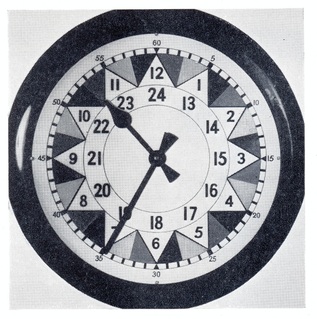OPERATIONS CENTRE CLOCK
Colour Sector Clocks were used in all Royal Air Force and Royal Observer Corps Operations Rooms during WW2 and continued in use for aircraft plotting until 1960.
The dial of a Sector Clock had a very specific design to aid the complex efforts of RAF controllers. Radar would pick up approaching hostile aircraft well out to sea but once over the land, radar was, in the early years, “blind”. Aircraft were then tracked by numerous Royal Observer Corps Posts with information sent to ROC and RAF Operations Rooms. This included the altitude, bearing, and strength of approaching hostile or indeed allied aircraft.
Incoming reports at RAF Ops Rooms would be shown by colour coded flags of either red, yellow or blue according to time of receipt. ROC Ops Rooms used coloured arrows plotted on the Ops Table according to the position of the Minute Hand on the Coloured segment of the Sector Clock at a succession of 5 Minute intervals. This was later reduced to 2.5 Minute intervals as aircraft speeds increased during the end of WW2 and start of the Cold War. In addition, a metal plaque contained information on - aircraft type, height, number of aircraft, hostile or allied and designated track also was used to provide further information to the operations crew. This method allowed RAF interceptor squadrons to remain on the ground until necessary, thus saving enormous amounts of time and fuel. Fighter aircraft could then stay in the air for longer periods when required. Because of the speed of incoming enemy raiders, the RAF response had to be in minutes.
Without this very unique time coding system devised by the RAF, the British might not have been so successful in holding control of the skies over Britain in 1940 during the crucial Battle of Britain as well as later in the war. .
[Information kindly supplied by Paddy Malone - Long Kesh Aircraft Museum / ROC Museum - Northern Ireland]
The dial of a Sector Clock had a very specific design to aid the complex efforts of RAF controllers. Radar would pick up approaching hostile aircraft well out to sea but once over the land, radar was, in the early years, “blind”. Aircraft were then tracked by numerous Royal Observer Corps Posts with information sent to ROC and RAF Operations Rooms. This included the altitude, bearing, and strength of approaching hostile or indeed allied aircraft.
Incoming reports at RAF Ops Rooms would be shown by colour coded flags of either red, yellow or blue according to time of receipt. ROC Ops Rooms used coloured arrows plotted on the Ops Table according to the position of the Minute Hand on the Coloured segment of the Sector Clock at a succession of 5 Minute intervals. This was later reduced to 2.5 Minute intervals as aircraft speeds increased during the end of WW2 and start of the Cold War. In addition, a metal plaque contained information on - aircraft type, height, number of aircraft, hostile or allied and designated track also was used to provide further information to the operations crew. This method allowed RAF interceptor squadrons to remain on the ground until necessary, thus saving enormous amounts of time and fuel. Fighter aircraft could then stay in the air for longer periods when required. Because of the speed of incoming enemy raiders, the RAF response had to be in minutes.
Without this very unique time coding system devised by the RAF, the British might not have been so successful in holding control of the skies over Britain in 1940 during the crucial Battle of Britain as well as later in the war. .
[Information kindly supplied by Paddy Malone - Long Kesh Aircraft Museum / ROC Museum - Northern Ireland]
